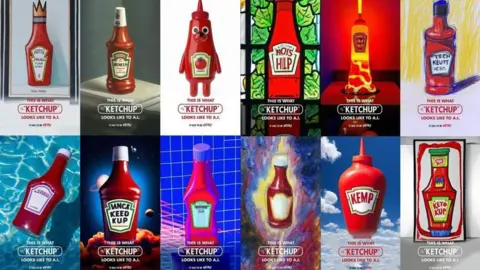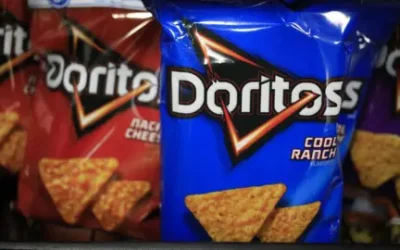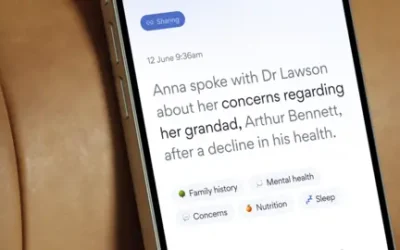In 2017, as Darby Hutchby pursued her visual communication degree, artificial intelligence (AI) was still in its nascent stages, a concept only just beginning to enter her academic awareness.
Eight years have fundamentally reshaped the employment landscape. Today, businesses are increasingly deploying artificial intelligence, often as an alternative to hiring human staff. This evolving dynamic has left many recent graphic design graduates expressing a stark reality: they now perceive themselves to be in direct competition with advanced technology for coveted job opportunities.
The increasing integration of this technology by major corporations, particularly within their marketing strategies, is yielding a dual impact. It is demonstrably constricting the job market by reducing available vacancies, while simultaneously elevating client expectations for more rapid and efficient work outcomes.
The rapid generative capabilities of artificial intelligence have recalibrated client expectations, with many now anticipating similar swift delivery from human designers. However, Ms. Hutchby, 27, a Birmingham City University alumna, highlighted a fundamental distinction, stating: “We adopt a much more personal approach to our work.”

Major brands quickly embraced artificial intelligence for their advertising campaigns, with Heinz and Coca-Cola providing prominent examples. In 2022, food industry leader Heinz leveraged OpenAI’s generative AI to produce 12 distinct images of its iconic ketchup, intended for a new advertisement. Following this trend, Coca-Cola unveiled a fully AI-generated Christmas commercial last year. This festive spot prominently featured the brand’s well-known truck and depicted consumers enjoying Coca-Cola Zero Sugar.
Fashion brand Mango has found itself at the center of controversy after deploying AI-generated teen models in its recent “Sunset Dream” campaign. The move sparked widespread criticism from the public, with many accusing the retailer of potentially displacing human jobs within the modeling industry and engaging in “false advertising.”

Following her 2020 university graduation, Ms. Hutchby embarked on a job hunt that stretched over a year, seeking a permanent creative role. This extensive search, often met with a distinct lack of response to her applications, prompted her to question the practical value of her academic degree.
She disclosed an immediate wave of apprehension, questioning whether the substantial investment of time and money in her degree would ever translate into an opportunity for practical application.
A Birmingham-based graphic design graduate, currently seeking to establish herself in the freelance market, is strategically enhancing her skill set by undertaking animation training. This initiative aims to give her a distinct advantage with clients, enabling her to offer a more comprehensive suite of services and, as she puts it, “bring as many strings to the bow as possible.”

The World Economic Forum (WEF), a prominent not-for-profit organization, forecasts a significant shift in the job market, identifying graphic design as one of the professions most rapidly approaching decline. By 2030, these roles are expected to diminish substantially, primarily due to the increasing advancements and adoption of artificial intelligence.
This sector is just one of many feeling the transformative impact of the technology. Companies across various industries are leveraging these advancements to enhance operational efficiency, often resulting in significant workforce reductions. A prominent example is the buy now, pay later giant, Klarna.
The company recently unveiled an AI-powered assistant designed for customer service, a technology that has since seen its deployment significantly expand. Officials report that the AI’s operational scope is now equivalent to the work performed by 800 human roles.

Ashleigh Sadler, a recent graphic design graduate from Sheffield Hallam University, has voiced concerns regarding the adequacy of her university’s preparation for the contemporary job market. Having completed her degree this past summer, Sadler suggested that the institution could have better equipped students with insights into the burgeoning advancements of artificial intelligence and the inherent challenges of securing employment post-graduation.
The rise of artificial intelligence poses a substantial threat to small businesses and is actively diminishing opportunities for designers, she noted. This trend is particularly unsettling for emerging professionals striving to establish a presence within the industry.
Faced with a challenging job market and limited hiring opportunities, a 21-year-old woman from Cleethorpes, Lincolnshire, revealed she was on the verge of retraining as a paramedic.
Here are a few options, maintaining a clear, journalistic tone:
**Option 1 (Concise):**
“After investing five years in their studies, the rapid ascent of artificial intelligence has reportedly caused one individual to question the fundamental value of their degree and the purpose of their extensive academic efforts.”
**Option 2 (Slightly more descriptive):**
“Having dedicated half a decade to rigorous academic pursuit, an individual has expressed how the recent advancements in artificial intelligence have prompted them to re-evaluate their qualification, sparking doubts about the ultimate relevance of their hard work.”
**Option 3 (Focus on the internal conflict):**
“The emergence of artificial intelligence has reportedly led an individual, who spent five years diligently studying, to critically assess their degree, wondering about the core purpose and utility of their significant academic investment.”
Currently working at a marketing agency, she expressed profound gratitude for securing employment, acknowledging the widespread difficulties many individuals she knew were facing in their job searches.

University of Brighton graduate Grace Warren described her post-graduation experience this year as an abrupt and challenging transition, akin to being “thrown into the deep end.” She attributed this sentiment to a perceived lack of sufficient guidance on internship opportunities and navigating the professional industry.
Here are a few options, maintaining a clear, journalistic tone:
**Option 1 (Direct and concise):**
She openly expressed feeling inadequately prepared, attributing it to the dramatic industry shifts that have occurred since her educators pursued their own university degrees.
**Option 2 (Focus on the knowledge gap):**
The individual stated she felt insufficiently equipped for the profession, noting a significant disconnect between current industry demands and the knowledge base of her lecturers, whose academic experiences predate these rapid changes.
**Option 3 (Emphasizing evolution):**
She candidly shared her sense of being underprepared, suggesting the industry has evolved profoundly since her university instructors completed their own studies, impacting the relevance of their teaching.
A 22-year-old from Bath holds a nuanced perspective on artificial intelligence. While acknowledging its complexities, she identifies AI as a significant opportunity, particularly for recent graduates. Her view emphasizes that by cultivating expertise in this technology, new professionals can strategically leverage it to gain a competitive edge in their future careers.
She highlighted an intense pressure within the job market, noting how easily one could feel compelled to operate like a “robot,” continuously acquiring a vast array of skills simply to meet the numerous demands outlined in job descriptions.
Here are a few options, maintaining a clear, journalistic tone:
**Option 1 (Focus on the competitive aspect):**
“The competitive dynamic introduced by artificial intelligence is reportedly cultivating a genuine sense of threat, leading individuals to experience heightened pressure and a strong impetus to outperform their AI counterparts, she explained.”
**Option 2 (Focus on the feeling of threat):**
“A legitimate feeling of being threatened by AI is emerging, she observed, as the direct competition with these advanced systems significantly intensifies the drive for individuals to achieve even greater levels of performance.”
**Option 3 (More concise):**
“According to one observer, the feeling of being threatened by artificial intelligence is a tangible reality, with the perceived competition creating heightened pressure for individuals to perform at an even higher standard.”

Dr. Rebecca Ross, an academic at the University of the Arts London, has dismissed the widespread belief that artificial intelligence (AI) will decimate the graphic design industry. She asserts that this is a misconception, predicting that designers will instead adapt and harness the technology in innovative and entirely unforeseen ways.
Here are a few options, maintaining a clear, journalistic tone:
**Option 1 (Concise):**
“Graphic design’s evolution has consistently paralleled technological breakthroughs, progressing from letterpress and phototypesetting to desktop publishing, and most recently, embracing Generative AI, she observed.”
**Option 2 (More Descriptive):**
“The trajectory of graphic design has always been intrinsically linked to technological shifts, spanning its journey from early methods like letterpress and phototypesetting, through the digital revolution of desktop publishing, and now extending into the capabilities of Generative AI, she explained.”
**Option 3 (Active Voice):**
“Technological innovation has continually shaped graphic design, guiding its development from mechanical letterpress and photographic typesetting to the digital realm of desktop publishing, and currently, the integration of Generative AI, she highlighted.”
Dr. Ross highlighted artificial intelligence’s capacity to unlock novel opportunities for designers. Yet, he underscored the “impossibility” of fully predicting the extent of its transformative impact on the industry.
The evolving landscape of entry-level employment reveals a distinct duality in employer preferences, largely influenced by the proliferation of artificial intelligence. While some companies are actively seeking graduates proficient in harnessing AI technologies, a contrasting trend sees others prioritizing candidates who possess “distinct voices” – individuals capable of delivering original perspectives to differentiate their work from the increasing “churn” of AI-generated content.
Here are a few options, maintaining the core meaning with a unique, engaging, and original journalistic tone:
**Option 1 (Emphasizing continuity):**
Dr. Rebecca Ross emphasized that the precision of a practiced human hand and the keenness of a human eye remain as crucial as ever.
**Option 2 (Focusing on expertise):**
According to Dr. Rebecca Ross, the vital role of human expertise, encompassing both the skilled hand and the discerning eye, continues to hold unwavering significance.
**Option 3 (Concise and direct):**
The essential value of the practiced human hand and discerning eye endures, Dr. Rebecca Ross noted.
**Option 4 (Highlighting human elements):**
Dr. Rebecca Ross underscored the enduring importance of human skill, asserting that the trained hand and perceptive eye retain their critical role.

Wiltshire-based creative agency Milk&Tweed prioritizes a proactive mindset and attitude as key criteria when evaluating potential new hires.
Founder Jake Jeffries particularly values hearing about projects completed without charge for family members or close acquaintances, such as a parent’s business or a friend. He sees these voluntary endeavors as a clear sign of an individual’s genuine passion and enjoyment for their craft.
He emphasized that innovative ideas remain critically important for a strong portfolio. Graduates, he advised, can significantly differentiate themselves by mastering industry-standard software like Adobe and proactively gaining real-world experience through their own initiative.
Mr. Jeffries underscored the critical importance of monitoring trends, asserting that these evolving patterns are not merely influential, but serve as the pivotal determinants shaping a project’s very identity. He emphasized that such attentiveness is crucial for crafting designs that achieve lasting recognition and remain memorable.







